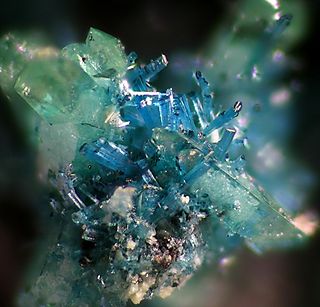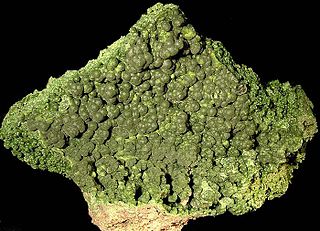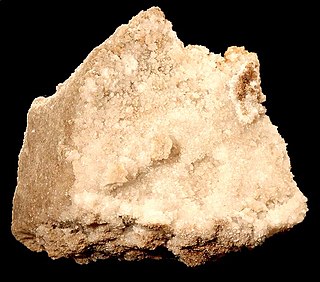
Hornblende is a complex inosilicate series of minerals. It is not a recognized mineral in its own right, but the name is used as a general or field term, to refer to a dark amphibole. Hornblende minerals are common in igneous and metamorphic rocks.

Amphibole is a group of inosilicate minerals, forming prism or needlelike crystals, composed of double chain SiO
4 tetrahedra, linked at the vertices and generally containing ions of iron and/or magnesium in their structures. Its IMA symbol is Amp. Amphiboles can be green, black, colorless, white, yellow, blue, or brown. The International Mineralogical Association currently classifies amphiboles as a mineral supergroup, within which are two groups and several subgroups.

Strontianite (SrCO3) is an important raw material for the extraction of strontium. It is a rare carbonate mineral and one of only a few strontium minerals. It is a member of the aragonite group.

Vivianite (Fe(II)
3(PO
4)
2·8H
2O) is a hydrated iron(II) phosphate mineral found in a number of geological environments. Small amounts of manganese Mn2+, magnesium Mg2+, and calcium Ca2+ may substitute for iron Fe2+ in its structure. Pure vivianite is colorless, but the mineral oxidizes very easily, changing the color, and it is usually found as deep blue to deep bluish green prismatic to flattened crystals. Vivianite crystals are often found inside fossil shells, such as those of bivalves and gastropods, or attached to fossil bone. Vivianite can also appear on the iron coffins or on the corpses of humans as a result of a chemical reaction of the decomposing body with the iron enclosure.

Scolecite is a tectosilicate mineral belonging to the zeolite group; it is a hydrated calcium silicate, CaAl2Si3O10·3H2O. Only minor amounts of sodium and traces of potassium substitute for calcium. There is an absence of barium, strontium, iron and magnesium. Scolecite is isostructural (having the same structure) with the sodium-calcium zeolite mesolite and the sodium zeolite natrolite, but it does not form a continuous chemical series with either of them. It was described in 1813, and named from the Greek word, σκώληξ (sko-lecks) = "worm" because of its reaction to the blowpipe flame.

Alstonite, also known as bromlite, is a low temperature hydrothermal mineral that is a rare double carbonate of calcium and barium with the formula BaCa(CO
3)
2, sometimes with some strontium. Barytocalcite and paralstonite have the same formula but different structures, so these three minerals are said to be trimorphous. Alstonite is triclinic but barytocalcite is monoclinic and paralstonite is trigonal. The species was named Bromlite by Thomas Thomson in 1837 after the Bromley-Hill mine, and alstonite by August Breithaupt of the Freiberg Mining Academy in 1841, after Alston, Cumbria, the base of operations of the mineral dealer from whom the first samples were obtained by Thomson in 1834. Both of these names have been in common use.

Barytocalcite is an anhydrous barium calcium carbonate mineral with the chemical formula BaCa(CO3)2. It is trimorphous with alstonite and paralstonite, that is to say the three minerals have the same formula but different structures. Baryte and quartz pseudomorphs after barytocalcite have been observed.

Leadhillite is a lead sulfate carbonate hydroxide mineral, often associated with anglesite. It has the formula Pb4SO4(CO3)2(OH)2. Leadhillite crystallises in the monoclinic system, but develops pseudo-hexagonal forms due to crystal twinning. It forms transparent to translucent variably coloured crystals with an adamantine lustre. It is quite soft with a Mohs hardness of 2.5 and a relatively high specific gravity of 6.26 to 6.55.

Vauxite is a phosphate mineral with the chemical formula Fe2+Al2(PO4)2(OH)2·6(H2O). It belongs to the laueite – paravauxite group, paravauxite subgroup, although Mindat puts it as a member of the vantasselite Al4(PO4)3(OH)3·9H2O group. There is no similarity in structure between vauxite and paravauxite Fe2+Al2(PO4)2(OH)2·8H2O or metavauxite Fe3+Al2(PO4)2(OH)2·8H2O, even though they are closely similar chemically and all minerals occur together as secondary minerals. Vauxite was named in 1922 for George Vaux Junior (1863–1927), an American attorney and mineral collector.

Nyerereite is a very rare sodium calcium carbonate mineral with formula Na2Ca(CO3)2. It forms colorless, platey pseudohexagonal orthorhombic crystals that are typically twinned. It has a specific gravity of 2.54 and indices of refraction of nα=1.511, nβ=1.533 and nγ=1.535. Nyerereite is not stable in contact with the atmosphere and rapidly breaks down. Collection specimens must be kept in a sealed argon environment.

The endmember hornblende tschermakite (☐Ca2(Mg3Al2)(Si6Al2)O22(OH)2) is a calcium rich monoclinic amphibole mineral. It is frequently synthesized along with its ternary solid solution series members tremolite and cummingtonite so that the thermodynamic properties of its assemblage can be applied to solving other solid solution series from a variety of amphibole minerals.

Plancheite is a hydrated copper silicate mineral with the formula Cu8Si8O22(OH)4•(H2O). It is closely related to shattuckite in structure and appearance, and the two minerals are often confused.

Keyite is a mineral with the chemical formula Cu2+3Zn4Cd2(AsO4)6 · 2H2O. The name comes from Charles Locke Key, an American mineral dealer who furnished its first specimens. Keyite is monoclinic-prismatic, meaning its crystal form has three unequal axes, two of which have 90° angles between them and one with an angle less than 90°. Keyite belongs to the biaxial optical class, meaning it has more than one axis of anisotropy, in which light travels with zero birefringence, and three indices of refraction, nα = 1.800, nβ, and nγ = 1.870. Being a very rare cadmium copper arsenate, keyite is only found in Tsumeb, Namibia in the Tsumeb mine, a world-famous copper mine known for its abundance of rare and unusual minerals.
This list gives an overview of the classification of minerals (silicates) and includes mostly International Mineralogical Association (IMA) recognized minerals and its groupings. This list complements the List of minerals recognized by the International Mineralogical Association series of articles and List of minerals. Rocks, ores, mineral mixtures, non-IMA approved minerals and non-named minerals are mostly excluded.

Ianbruceite is a rare hydrated zinc arsenate with the formula [Zn2(OH)(H2O)(AsO4)](H2O)2; material from the Driggith mine has traces of cobalt. It was first discovered at Tsumeb, approved by the International Mineralogical Association as a new mineral species in 2011, reference IMA2011-49, and named for Ian Bruce, who founded "Crystal Classics" in the early 1990s, and was heavily involved in attempts to reopen the famous Tsumeb mine for specimen mining.
In 2013 new occurrences of ianbruceite were reported from the neighbouring Driggith and Potts Gill mines on High Pike in the Caldbeck Fells, Cumbria, England. Here the mineral is probably a post-mining product. Caldbeck Fells and Tsumeb are the only reported localities for ianbruceite to date (May 2013).

Köttigite is a rare hydrated zinc arsenate which was discovered in 1849 and named by James Dwight Dana in 1850 in honour of Otto Friedrich Köttig (1824–1892), a German chemist from Schneeberg, Saxony, who made the first chemical analysis of the mineral. It has the formula Zn3(AsO4)2·8H2O and it is a dimorph of metaköttigite, which means that the two minerals have the same formula, but a different structure: köttigite is monoclinic and metaköttigite is triclinic. There are several minerals with similar formulae but with other cations in place of the zinc. Iron forms parasymplesite Fe2+3(AsO4)2·8H2O; cobalt forms the distinctively coloured pinkish purple mineral erythrite Co3(AsO4)2·8H2O and nickel forms annabergite Ni3(AsO4)2·8H2O. Köttigite forms series with all three of these minerals and they are all members of the vivianite group.

Carminite (PbFe3+2(AsO4)2(OH)2) is an anhydrous arsenate mineral containing hydroxyl. It is a rare secondary mineral that is structurally related to palermoite (Li2SrAl4(PO4)4(OH)4). Sewardite (CaFe3+2(AsO4)2(OH)2) is an analogue of carminite, with calcium in sewardite in place of the lead in carminite. Mawbyite is a dimorph (same formula, different structure) of carminite; mawbyite is monoclinic and carminite is orthorhombic. It has a molar mass of 639.87 g. It was discovered in 1850 and named for the characteristic carmine colour.

Serpierite (Ca(Cu,Zn)4(SO4)2(OH)6·3H2O) is a rare, sky-blue coloured hydrated sulfate mineral, often found as a post-mining product. It is a member of the devilline group, which has members aldridgeite (Cd,Ca)(Cu,Zn)4(SO4)2(OH)6·3H2O, campigliaite Cu4Mn2+(SO4)2(OH)6·4H2O, devilline CaCu4(SO4)2(OH)6·3H2O, kobyashevite Cu5(SO4)2(OH)6·4H2O, lautenthalite PbCu4(SO4)2(OH)6·3H2O and an unnamed dimorph of devilline. It is the calcium analogue of aldridgeite and it is dimorphous with orthoserpierite CaCu4(SO4)2(OH)6·3H2O.

Mottramite is an orthorhombic anhydrous vanadate hydroxide mineral, PbCu(VO4)(OH), at the copper end of the descloizite subgroup. It was formerly called cuprodescloizite or psittacinite (this mineral characterized in 1868 by Frederick Augustus Genth). Duhamelite is a calcium- and bismuth-bearing variety of mottramite, typically with acicular habit.

Talmessite is a hydrated calcium magnesium arsenate, often with significant amounts of cobalt or nickel. It was named in 1960 for the type locality, the Talmessi mine, Anarak district, Iran. It forms a series with β-Roselite, where cobalt replaces some of the magnesium, and with gaitite, where zinc replaces the magnesium. All these minerals are members of the fairfieldite group. Talmessite is dimorphic with wendwilsonite.




















